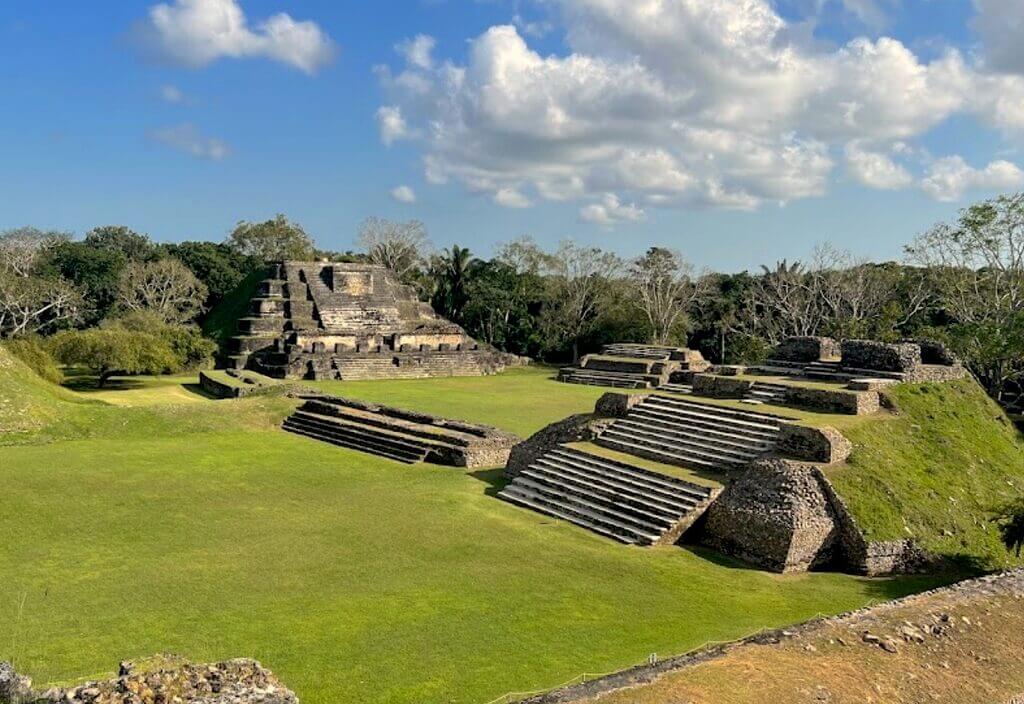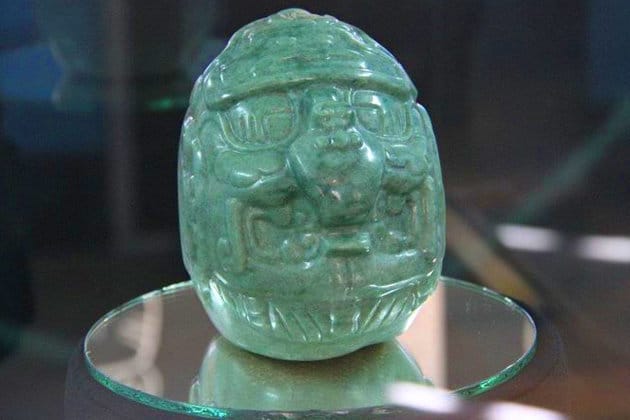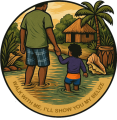The Jade Head of Belize: Maya Masterpiece and National Treasure
Walk with me, and I’ll show you a story carved in stone.
🌿 What Is the Jade Head?
The Jade Head of Belize is the country’s most treasured Maya artifact. Carved from a single block of jadeite, it weighs almost 10 pounds (4.42 kg) and stands about 6 inches tall. It is believed to represent Kinich Ahau, the Maya Sun God, though some scholars suggest it could be a ruler’s portrait imbued with divine traits.
It remains the largest carved jade object ever found in the Maya world — unmatched in scale and workmanship.
⛏️ How It Was Made
The Maya had no metal tools, no wheels, and no beasts of burden. Yet they shaped this massive stone using only harder stones, bone tools, and sand as an abrasive, polishing it smooth until a face of power emerged.
This was not art for beauty alone. Jade was sacred — a symbol of life, breath, and rulership. To carve a head of this size was to place the sun itself inside a temple.
🗺️ Discovery at Altun Ha
The Jade Head was discovered in March 1968 beneath the Temple of the Masonry Altars (Structure B-4) at Altun Ha, about 31 miles north of Belize City. The tomb dated to 600–650 AD (Late Classic period) and contained the remains of an elite male, buried with more than 40 other artifacts of jade, shell, and obsidian.
Placed beneath the stairway of a great temple, the head was both protection and proclamation: the Sun God watching over the city.

👥 The Men Who Found It
For decades, history credited archaeologist Dr. David Pendergast of the Royal Ontario Museum. But the truth is more human.
The men who actually uncovered the Jade Head were Wilhelm “Busta” Leslie and Winston Herbert, villagers from Rockstone Pond–Lucky Strike. Working as assistants to Pendergast, they were the ones inside the chamber who brushed away the dirt beneath a capstone and revealed the face of jade.
They pressed on when told the work was dangerous. They uncovered what guides now call the “Crown Jewel of Altun Ha.” Yet their names rarely appear in history books. Leslie passed away in 2014 at age 80, remembered locally but still under-credited in the national story.
When we tell the story of the Jade Head, we must remember not only the rulers it honored, but also the hands of Belizeans who lifted it from the soil.
🏛 Where It Is Today
sThe Jade Head is so valuable that the original is kept securely in the vaults of the Central Bank of Belize. Replicas are displayed at the Museum of Belize in Belize City, where travelers can also see exhibits of Maya pottery, carvings, and colonial history.
Stopping here before visiting Altun Ha gives you context — helping you imagine not just the temples, but the treasures they once held.

💎 Beyond the Jade Head: The Wind Jewels
The Jade Head may be Belize’s most famous treasure, but it is not alone. In October 2024, the Museum of Belize unveiled a new exhibition called Maya Creating Civilization, featuring three jade pendants known as Wind Jewels.
One of these is now recognized as the second largest jade object ever found in Belize — second only to the Jade Head itself.
According to Melissa Badillo, Director of the Institute of Archaeology, the Wind Jewels were central to Maya agriculture and ritual. They were worn during ceremonies marking the start and end of planting cycles, linking the power of jade to the survival of the people.
At Nim Li Punit, a burial crypt (Structure 7) yielded one such Wind Jewel. Though no human remains were found, the artifact matched carvings on a nearby stela that depicts a ruler wearing the same pendant. Hieroglyphs even suggest he put on the jewel specifically to carry out scattering ceremonies tied to agriculture.
The Jade Head represents rulership and divine power, but the Wind Jewels remind us of something equally vital: sustenance, cycles, and survival.
🌞 Why It Matters
The Jade Head and Wind Jewels speak across centuries:
- Trade and power → Their jade came from the Motagua River Valley in Guatemala, showing the vast reach of Maya networks.
- Faith and artistry → They embodied divine authority and agricultural cycles.
- Continuity → What the Maya carved still shapes Belize today. The Jade Head appears on our currency, while the Wind Jewels now have a place in exhibitions and classrooms.
Together, they remind us that jade in Belize was never just decoration. It was the very heart of survival and ceremony.
🌀 Closing Reflection
When you stand at Altun Ha or Nim Li Punit, the temples may feel silent. But beneath their stones lies the echo of discovery — from the rulers who wore jade, to the villagers who lifted it into the light, to the nation that now treasures it.
The Jade Head and the Wind Jewels are not just artifacts. They are mirrors — reflecting survival, craftsmanship, and identity. And they remind us that Belize’s story is not carved once, but many times, in green stone.

